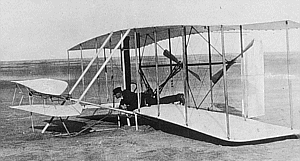
The "Flyer" after it's first 3 1/2 second flight
When the machine had been fastened with a wire to the track, so that it could not start until released by the operator, and the motor had been run to make sure that it was in condition, we tossed a coin to decide who should have the first trial. Wilbur won. I took a position at one of the wings intending to help balance the machine as it ran down the rack. But when the restraining wire was slipped, the machine started off so quickly I could stay with it only a few feet. After a 35- to 40-foot run, it lifted from the rail. But it was allowed to turn up too much. It climbed a few feet, stalled, and then settled to the ground near the foot of the hill, 105 feet below. My stop watch showed that I had been in the air just 3 l/2 seconds. In landing the left wing touched first. The machine swung around, dug the skids into the sand and broke one of them. Several other parts were also broken, but the damage to the machine was not serious. While the test had shown nothing as to whether the power of the motor was sufficient to keep the machine up, since the landing was made many feet below the starting point, the experiment had demonstrated that the method adopted for launching the machine was a safe and practical one. On the whole, we were much pleased.

The "Flyer" after it's first 3 1/2 second flight
Two days were consumed in making repairs, and the machine was not ready again till late in the afternoon of the 16th. While we had it out on the track in front of the building, making the final adjustments, a stranger came along. After looking at the mach ine a few seconds he inquired what it was When we told him it was a flying machine he asked whether we intended to fly it. We said we did, as soon as we had a suitable wind. He looked at it several minutes longer and then, wishing to be courteous, remarked that it looked as if it would fly, if it had a "suitable wind." We were much amused, for, no doubt, he had in mind the recent 75-mile gale when he repeated our words, "a suitable wind!"
During the night of December 16, 1903, a strong cold wind blew from the north When we arose on the morning of the 17th, the puddles of water, which had been standing about the camp since the recent rains, were covered with ice. The wind had a velocity of 10 to 12 meters per second (22 to 27 miles an hour). We thought it would die down before long, and so remained indoors the early part of the morning. But when ten o'clock arrived, and the wind was as brisk as ever, we decided that we had better get the machine out and attempt a flight. We hung out the signal for the men of the Life Saving Station. We thought that by facing the flyer into a strong wind, there ought to be no trouble in launching it from the level ground about camp. We realized the difficulties of flying in so high a wind, but estimated that the added dangers in flight would be partly compensated for by the slower speed in landing.
| Prev Page | Next Page |